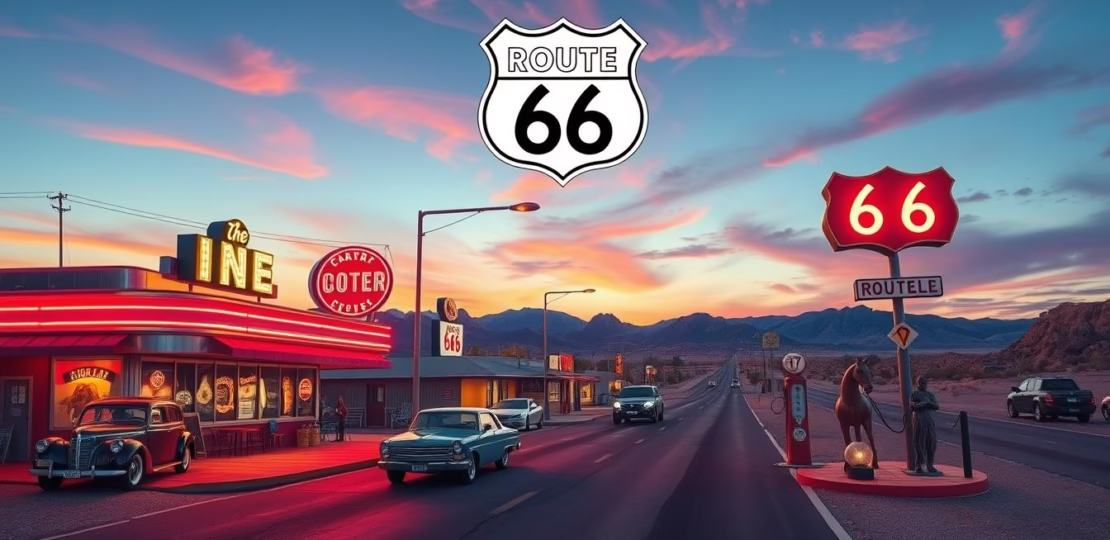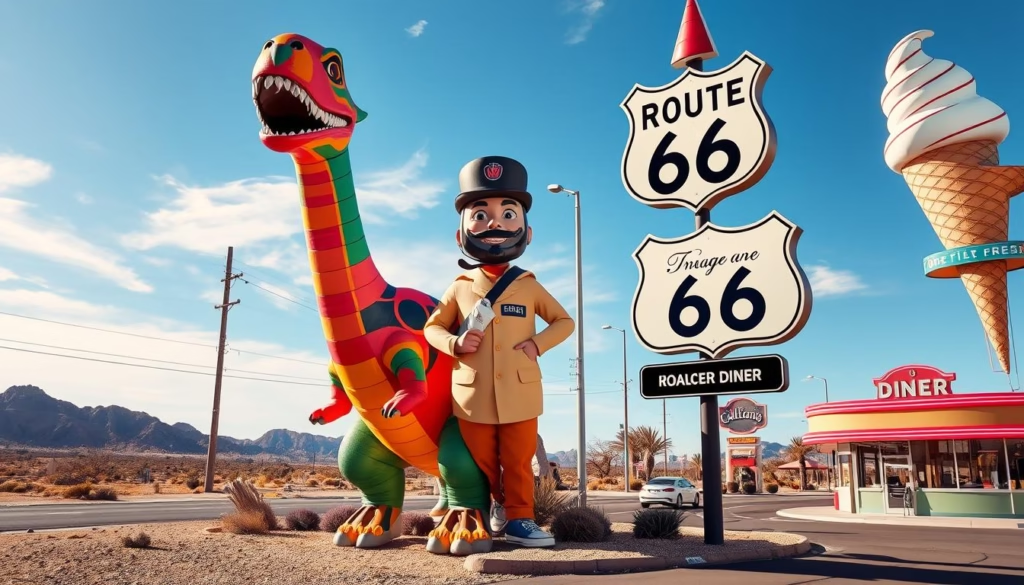Route 66: Top Attractions and Must-See Stops Along the Way
January 8, 2025 | by m33559844@gmail.com

Ever wondered why Route 66 is called America’s Main Street? It’s a historic highway filled with treasures waiting for travelers. Built in 1926, it stretches 2,448 miles from Chicago to Los Angeles, passing through eight states. Each state has its own attractions that show the heart of American culture.
John Steinbeck called it the Mother Road in “The Grapes of Wrath.” It symbolizes freedom and adventure. Road trippers find a world of roadside attractions that tell old stories.
Even though it was decommissioned in 1985, Route 66’s legacy lives on. The Route 66 Corridor Preservation Program works to protect its history and landmarks1. From the World’s Largest Catsup Bottle in Illinois to the Grand Canyon near Williams, AZ, there’s much to see. It’s a journey that captures the essence of America23.
Key Takeaways
- Route 66 spans eight states and is a cultural icon in American history.
- The road is famous for its historic significance and unique roadside attractions.
- It will celebrate its 100th anniversary in 2026, marking a century of adventure.
- Each state along Route 66 offers distinct attractions that reflect local heritage.
- Despite being decommissioned, efforts are underway to preserve its legacy.
If you’re ready to kickstart your travel journey with ease and exclusive savings, book your first trip now! Visit Trip.com using this special promotion link and register to reserve tickets, accommodation, and more. Don’t miss out on these incredible travel deals tailored for first-time travelers—start planning today!
Introduction to Route 66
Route 66 is known as America’s Main Street. It stretches for an impressive 2,448 miles across eight states. This historic highway was first opened on November 11, 19264. It connects travelers to the heart of American culture and history.
This legendary road links Chicago to Los Angeles. It takes you through different landscapes, from cities to deserts. By World War II, more cars were on the road, making it a key military route5.
Even though it was officially closed in 1985, Route 66 is loved by many. In 1990, it was recognized as a key part of American heritage5. Today, it brings back memories of the past and inspires new adventures.
Historical Significance of Route 66
Route 66 was officially designated in 1926. It stretches about 2,448 miles from Chicago to Los Angeles. It’s known as America’s highway67.
It became famous as the “Mother Road” thanks to John Steinbeck’s The Grapes of Wrath in 1939. This title shows its importance in American history67.
During the Dust Bowl, about 210,000 people moved to California. Route 66 was their lifeline. It helped families move westward7.
Between 1933 and 1938, thousands of young people worked on the road. They paved Route 66. By 1938, it was fully paved7.
Cyrus Avery wanted a road from the Midwest to the West in the early 1900s. By the 1930s, trucks preferred Route 66 for its easier drive. This made it popular after World War II for family road trips6.
The Federal Aid Highway Act of 1956 marked Route 66’s decline. By 1970, most of it was replaced by modern highways67. The National Historic Route 66 Federation was formed to save its history. It ensures Route 66’s legacy lives on through stories, music, and art6.
Must-See Stops on Route 66
Traveling along Route 66 lets you see many must-see stops from around the world. Each place has its own story, making your trip unforgettable. Here are some highlights you can’t miss:
The Gateway Arch in St. Louis
The Gateway Arch stands at 630 feet, the tallest monument in the U.S. It symbolizes westward expansion. You can take a tram to the top for amazing views of St. Louis. Below, a museum shows the arch’s importance in American history8.
Meramec Caverns: A Glimpse into History
Meramec Caverns has a huge cave system of 4.6 miles. It’s famous for its stunning rock formations, like the seven-story Wine Table. It’s been a tourist spot for decades, with tours that let you see its beauty. It’s also linked to Jesse James, adding mystery to your visit8.
The Blue Whale of Catoosa
The Blue Whale of Catoosa is a fun roadside attraction built in the early 1970s. It was meant as a family swimming spot and now invites you to explore. You can walk inside and enjoy the park. The City of Catoosa bought it in 2020, and it’s a hit with its playful design9.
Classic Americana Along Route 66
Route 66 is a treasure trove of classic Americana experiences. It invites travelers on a nostalgic road trip that celebrates the spirit of the open road. Along this iconic route, unique roadside attractions capture the essence of American culture and creative expression.
The Gemini Giant: A Nostalgic Muffler Man
The Gemini Giant is a striking 30-foot-tall Muffler Man in Wilmington, Illinois. It’s at the Launching Pad drive-in. This landmark symbolizes the golden age of roadside attractions, standing as a proud reminder of retro Americana from the 1960s.
It serves not just as a statue, but as a testament to a different time in American history. When such figures lined highways and beckoned travelers to stop and explore.
Cadillac Ranch: An Iconic Art Installation
Near Amarillo, Texas, visitors can find Cadillac Ranch. It’s a captivating public art installation featuring ten half-buried Cadillacs. This site is a brilliant example of American creativity and self-expression.
Tourists are encouraged to spray paint the cars, leaving their mark as part of a communal canvas. This roadside attraction not only draws attention for its vibrant artwork. It also represents the playful spirit and innovation prevalent in classic Americana.

If you’re ready to kickstart your travel journey with ease and exclusive savings, book your first trip now! Visit Trip.com using this special promotion link and register to reserve tickets, accommodation, and more. Don’t miss out on these incredible travel deals tailored for first-time travelers—start planning today!
| Attraction | Location | Significance |
|---|---|---|
| The Gemini Giant | Wilmington, Illinois | Symbol of nostalgic Americana, retro advertising |
| Cadillac Ranch | Amarillo, Texas | Interactive public art, creativity and self-expression |
Traveling along Route 66 offers a chance to engage with classic Americana like never before. It creates memorable experiences that resonate with any traveler on a nostalgic road trip. As more than 3 million people drive part of Route 66 each year, the charm of these roadside attractions continues to live on. They prove their importance beyond mere nostalgia101112.
Natural Wonders of Route 66
Traveling on Route 66 is a chance to see amazing natural wonders. This historic road goes through different landscapes, showing America’s geological beauty. The Petrified Forest National Park and Meteor Crater are two must-see spots for nature lovers and history buffs.
Petrified Forest National Park
In Arizona, the Petrified Forest National Park is known for its stunning views and ancient petrified logs. These logs are over 200 million years old, from the Triassic Period. Visitors can see colorful badlands and scenic views on hiking trails. It’s a great place to learn about Earth’s history, making it a key stop on Route 6613.
Meteor Crater: Earth’s Best Preserved Impact Site
Meteor Crater, also called Barringer Crater, is a major geological site on Route 66. It was made about 50,000 years ago by a meteorite. The crater is 3,900 feet wide and over 550 feet deep, with a rim 148 feet high1314. There are educational exhibits and an observation deck for visitors. Meteor Crater is a thrilling stop on any Route 66 trip.
| Natural Wonder | Highlight | Location |
|---|---|---|
| Petrified Forest National Park | Petrified logs over 200 million years old | Arizona |
| Meteor Crater | Diameter of 3,900 feet and historical significance | Arizona |
Quirky Roadside Attractions
Traveling Route 66 isn’t complete without visiting quirky roadside attractions. These spots capture the spirit of adventure and nostalgia. They’re perfect for a memorable photo or a fun detour.
The Leaning Tower of Texas
The Leaning Tower of Texas is a tilted water tower at 80 degrees. It’s not just a water tower; it’s a whimsical photo spot. Standing tall, it draws travelers to explore more.
The Devil’s Rope Museum: Celebrating Barbed Wire
In McLean, Texas, the Devil’s Rope Museum showcases barbed wire’s history. It has over 2,000 exhibits on this farm tool’s cultural significance. This stop connects visitors with the region’s agricultural past.

| Attraction | Description | Location |
|---|---|---|
| Leaning Tower of Texas | Intentionally tilted water tower attracting tourists with its unique structure. | Texas |
| Devil’s Rope Museum | Museum dedicated to the history of barbed wire. | McLean, Texas |
These attractions along Route 66 show the charm of classic Americana. They offer unique stories, making any road trip special15.
Road Trip Food Stops on Route 66
Exploring Route 66 means trying local foods at roadside eateries. These stops offer unique tastes and memorable meals. Each bite is as special as the views along this historic road.
66 Diner in Albuquerque
The 66 Diner in Albuquerque is a top spot for a nostalgic meal. Its retro look and lively vibe make it perfect for comfort food lovers. Enjoy burgers, milkshakes, and sodas that bring back the good old days. It’s a key stop for anyone wanting to taste classic Americana16.
Ted Drewes Frozen Custard in St. Louis
Ted Drewes Frozen Custard is a legendary stop on Route 66. It has been serving rich frozen custard for over 90 years. The famous “concrete” dessert is a must-try for its thick, creamy texture. It’s a key part of St. Louis’s history, making it a must-visit for Route 66 diners17.
Iconic Motels and Accommodations
Travelers on Route 66 can find many iconic motels. These places show the nostalgic charm of this historic highway. The Wigwam Village in Holbrook and the Barfield Hotel in Amarillo are among the most memorable.
Wigwam Village in Holbrook
The Wigwam Village has rooms that look like traditional tipis, built in 1950. It’s a beloved spot for those who love nostalgic travel on Route 66. Its unique structures have drawn visitors for over 70 years, adding to its historical charm18.
The welcoming vibe and special architecture make it a must-see for travelers.
The Barfield Hotel in Amarillo
The Barfield Hotel is a mix of luxury and history in Amarillo’s heart. It’s in a historic building but offers modern comforts. Its rich history and stylish rooms make it perfect for those who want comfort and a taste of the past19.
It shows the importance of Route 66 accommodations. Every guest feels connected to the adventurous spirit of the open road.

If you’re ready to kickstart your travel journey with ease and exclusive savings, book your first trip now! Visit Trip.com using this special promotion link and register to reserve tickets, accommodation, and more. Don’t miss out on these incredible travel deals tailored for first-time travelers—start planning today!
Exploring Main Street America
Main Street America is all about small-town life, full of history and charm. Along Route 66, you’ll find many historical towns. These towns, like Springfield, Missouri, and Tulsa, Oklahoma, keep their old buildings and museums. They give us a peek into the past.
Historical Towns and Their Significance
These towns are key to understanding American history. They mark Route 66, connecting us to the past. During the Great Depression, 2.5 million people left the Great Plains, with 400,000 going to California via Route 6620. Their stories and events add to Route 66’s rich culture.
Unique Local Shops and Culture
Route 66 is full of unique local shops. You can find everything from antique treasures to handmade crafts. These shops support local artists and keep traditional skills alive. They are the heart of their communities, showing their spirit. Oklahoma has over 400 miles, filled with local treasures21.
| Town | Significant Attraction | Historical Note |
|---|---|---|
| Springfield, MO | Route 66 Car Museum | Highlights the automotive history along Route 66 |
| Tulsa, OK | Woody Guthrie Center | Celebrates the life and work of the renowned folk legend |
| Gallup, NM | El Rancho Hotel | Built in the 1930s, iconic for its Hollywood star rooms |
| Barstow, CA | Route 66 Museum | Showcases memorabilia and history of the legendary route |
Conclusion
Route 66 is a unique journey through America’s history, culture, and landscapes. It spans 2,400 miles from Chicago to Santa Monica. This trip is filled with attractions like vintage diners and motels, making it a must-see for adventurers22.
The road has a rich history, starting in 1926. It was a lifeline for families during tough times like the Great Depression and Dust Bowl23.
Today, offers unforgettable experiences. You can enjoy local food at historic diners or see the beauty of national parks like the Grand Canyon22. Its popularity, boosted by films and music, helps local communities celebrate their heritage23.
Pacific Coast Highway: The Ultimate Road Trip Guide . Route 66 is perfect for history buffs, food lovers, or anyone seeking nostalgia. It’s more than a road; it’s a dive into the heart of America. Every mile tells a story that connects generations, making this trip a key part of American culture22.
FAQ
What is Route 66?
Route 66, also called America’s Main Street, is a historic road. It runs 2,448 miles from Chicago to Los Angeles. Built in 1926, it’s famous for its unique attractions and classic American feel.
Why is Route 66 referred to as the Mother Road?
The term “Mother Road” comes from John Steinbeck’s “The Grapes of Wrath.” It symbolizes hope and opportunity for families migrating west during the Dust Bowl era.
Are there any attractions I shouldn’t miss on Route 66?
Yes! Don’t miss the Gateway Arch in St. Louis, Meramec Caverns, the Blue Whale of Catoosa, and Cadillac Ranch near Amarillo. They showcase Route 66’s history and travel nostalgia.
How long does it take to drive Route 66?
Driving Route 66’s time varies by your pace. A slow trip with stops takes about 2 to 3 weeks. This lets you fully enjoy the journey.
Is Route 66 a popular travel destination?
Yes! Route 66 is a favorite among travelers. It draws millions each year with its history, road trip fun, and unique attractions.
What happened to Route 66 after it was decommissioned?
Route 66 was decommissioned in 1985. But, efforts like the Route 66 Corridor Preservation Program, started in 1999, keep its legacy alive. They protect its historic and cultural value.
Can I find unique food stops along Route 66?
Definitely! You’ll find places like 66 Diner in Albuquerque and Ted Drewes Frozen Custard in St. Louis. They offer classic diner food and sweet treats.
Are there any quirky attractions on Route 66?
Yes! Route 66 has attractions like the Leaning Tower of Texas and the Devil’s Rope Museum. These spots add to the road’s charm.
What is the significance of historical towns along Route 66?
Towns like Springfield, MO, and Tulsa, OK, are key. They show America’s rich history. Visitors can see preserved buildings, museums, and local culture, telling the stories of these communities.
RELATED POSTS
View all



